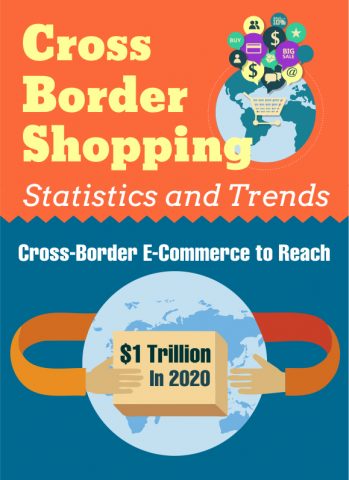全球跨境貿易正在迅速膨脹,預計到2020年,其價值將達到1萬億美元。
在過去幾年中,這一趨勢一直在獲得特殊的勢頭,因為全球跨境商業的規模僅為2.3億美元在2014年。
為了更好地了解跨境電子商務的全球採購行為,阿里巴巴集團的研究公司AliResearch做了一份名為“跨境B2C電子商務市場趨勢”的研究,得出結論,在未來5年內增長27.4%。
預測顯示,到2020年,將有近10億人將是跨境買家。這將佔全世界交易的近三分之一。
Ipsos研究代表PayPal恰當地捕捉了全球在線購物的一些更廣泛的趨勢。報告顯示,在加拿大,美國,澳大利亞,中國,新加坡,日本和印度等著名國家中,海外購物的增長趨勢。
例如,54%的美國在線購物者在海外購物,而67%的加拿大在線購物者在國外購物。

什麼因素促成了跨境購物的增長趨勢?
第一件事。當購物與價格,以及在一個國家沒有的獨特或特色產品有關時,人們看不到邊界的主要原因。
隨著跨境電子商務網絡的不斷發展,網上購物者在海外發現新的或更便宜的產品。
59%的千禧一代說他們在線購買產品,因為他們時尚且便宜。
技術還使得購物者能夠在國外發現產品。今天的買家精通各種國家生產的各種產品,以及涉及的採購,運輸和稅務流程,感謝技術。
智能手機和平板電腦一直是跨越廣泛購物興起的主要催化劑。千禧一代開放採用新技術,提高在線購物體驗
跨境電子商務(跨境電商)跨界障礙
跨境購物並不總是一帆風順。正在考慮跨境購物的消費者表示,高運輸成本以及長交貨期是他們面臨的主要障礙。
一些消費者也抱怨說,不符合描述的劣質產品。事務性安全問題也是另一個士氣的殺手。
儘管如此,跨境購物為企業和營銷人員提供了一個很好的機會利用。被限制在一個國家邊界狹窄地帶的日子已經過去了。
現在是擴大電子商務邊界,獲得海外購物獎勵的時候了。
How Cross-Border Ecommerce is Growing
The global cross-border commerce is ballooning with forecasts showing its value will hit the $1 trillion mark by 2020. This trend has been gaining exceptional momentum over the past few years given the fact that the size of global cross-border commerce was only $230 million in 2014.
In a bid to better make sense of global purchasing behavior in cross-border e-commerce, Alibaba Group’s research firm, AliResearch did a research titled “Cross-border B2C E-commerce Market Trends.” It concluded that the trend will experience a compound growth of 27.4% over the next 5 years. The forecasts show that almost 1 billion people will be cross-border buyers by the year 2020. This will account for almost a third of all worldwide transactions.
Some of the broader trends in global online shopping have been aptly captured by Ipsos research on behalf of PayPal. The report shows a growing trend of overseas shopping among prominent countries such as Canada, US, Australia, China, Singapore, Japan and India, among others. For instance, 54% of US online shoppers made overseas purchases while 67% of Canadian online shoppers made purchases abroad.
What factors have contributed to the growing trend of cross-border shopping?
First things first. The main reason people look beyond borders when shopping has to do with prices as well as unique or specialty products that aren’t available in one’s country. As the cross-border eCommerce network continues to develop, online shoppers discover new or cheaper products overseas. 59% of millennial say they buy products online because they are fashionable and cheaper.
Technology has also made it possible for shoppers to discover products abroad. Today’s buyer is well versed with various products produced by various countries as well as the purchasing, shipping and taxation processes involved, thanks to technology. Smartphones and tablets have been the main catalysts in the rise of cross-broader shopping. Millennial are open to adopting new technologies that enhance online shopping experience
Cross-border obstacles
Cross-border shopping is not always a smooth sailing. Consumers who are considering cross-border shopping say high shipping costs as well as long delivery periods as the main obstacles they face. Some consumers have also complained about inferior products that don’t match description. Transactional security issues is also another morale killer.
That notwithstanding, cross-border shopping presents a great opportunity for businesses and marketers to exploit. The days of being confined to the narrow confines of one’s country borders are long gone. It is time to expand the e-commerce boundaries and reap the rewards of overseas shopping.







